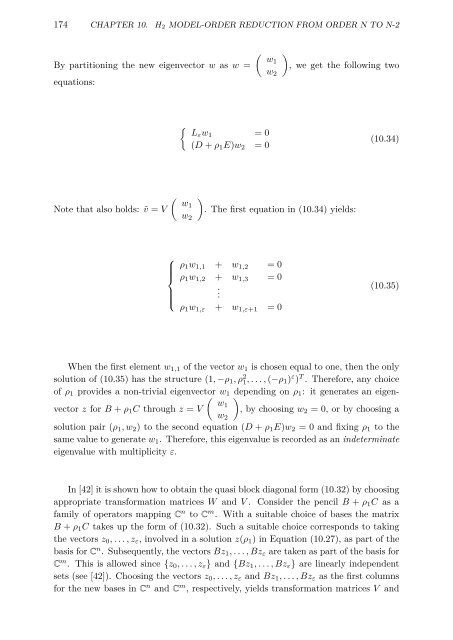link to my thesis
link to my thesis
link to my thesis
You also want an ePaper? Increase the reach of your titles
YUMPU automatically turns print PDFs into web optimized ePapers that Google loves.
174 CHAPTER 10. H 2 MODEL-ORDER REDUCTION FROM ORDER N TO N-2<br />
By partitioning the new eigenvec<strong>to</strong>r w as w =<br />
equations:<br />
(<br />
w1<br />
w 2<br />
)<br />
, we get the following two<br />
{<br />
Lε w 1 =0<br />
(D + ρ 1 E)w 2 =0<br />
(10.34)<br />
Note that also holds: ṽ = V<br />
(<br />
w1<br />
w 2<br />
)<br />
. The first equation in (10.34) yields:<br />
⎧<br />
⎪⎨<br />
⎪⎩<br />
ρ 1 w 1,1 + w 1,2 =0<br />
ρ 1 w 1,2 + w 1,3 =0<br />
.<br />
ρ 1 w 1,ε + w 1,ε+1 =0<br />
(10.35)<br />
When the first element w 1,1 of the vec<strong>to</strong>r w 1 is chosen equal <strong>to</strong> one, then the only<br />
solution of (10.35) has the structure (1, −ρ 1 ,ρ 2 1,...,(−ρ 1 ) ε ) T . Therefore, any choice<br />
of ρ 1 provides a non-trivial eigenvec<strong>to</strong>r<br />
(<br />
w 1<br />
)<br />
depending on ρ 1 : it generates an eigenvec<strong>to</strong>r<br />
z for B + ρ 1 C through z = V , by choosing w 2 = 0, or by choosing a<br />
w1<br />
w 2<br />
solution pair (ρ 1 ,w 2 ) <strong>to</strong> the second equation (D + ρ 1 E)w 2 = 0 and fixing ρ 1 <strong>to</strong> the<br />
same value <strong>to</strong> generate w 1 . Therefore, this eigenvalue is recorded as an indeterminate<br />
eigenvalue with multiplicity ε.<br />
In [42] it is shown how <strong>to</strong> obtain the quasi block diagonal form (10.32) by choosing<br />
appropriate transformation matrices W and V . Consider the pencil B + ρ 1 C as a<br />
family of opera<strong>to</strong>rs mapping C n <strong>to</strong> C m . With a suitable choice of bases the matrix<br />
B + ρ 1 C takes up the form of (10.32). Such a suitable choice corresponds <strong>to</strong> taking<br />
the vec<strong>to</strong>rs z 0 ,...,z ε , involved in a solution z(ρ 1 ) in Equation (10.27), as part of the<br />
basis for C n . Subsequently, the vec<strong>to</strong>rs Bz 1 ,...,Bz ε are taken as part of the basis for<br />
C m . This is allowed since {z 0 ,...,z ε } and {Bz 1 ,...,Bz ε } are linearly independent<br />
sets (see [42]). Choosing the vec<strong>to</strong>rs z 0 ,...,z ε and Bz 1 ,...,Bz ε as the first columns<br />
for the new bases in C n and C m , respectively, yields transformation matrices V and

















